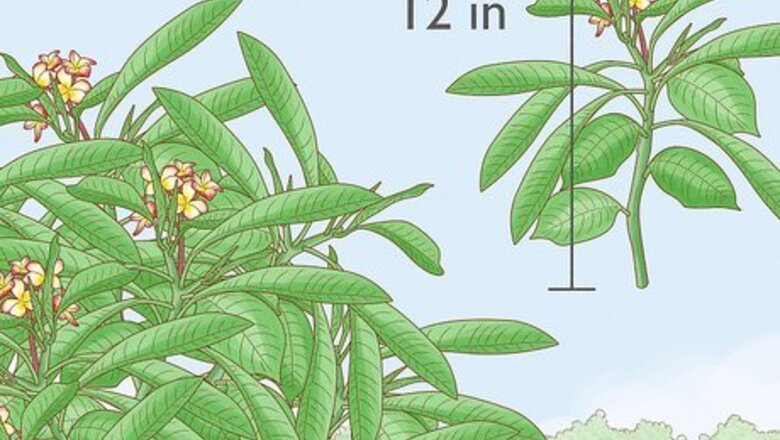
views
- Harvest a 12-inch (30 cm) cutting from a brown or dark green plumeria branch, and strip the leaves off.
- Dry your cutting in a shady, humid area for 1-2 weeks before planting to ensure it callouses over and dries out.
- Plant your cutting in a 1 gallon (3.8 l) pot filled with 2 parts perlite and 1 part fast-draining potting soil.
Stripping and Drying the Cutting
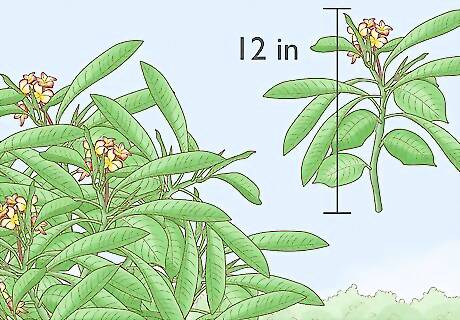
Use thick, healthy cuttings that are least 12 inches (30 cm) or longer. To take a cutting, use a pair of pruning shears to cut off a thick, healthy-looking branch from a mature plumeria plant. Target brown or darker green branches, as these colors indicate that the branches are mature and suitable for cutting. If you're making the cuts yourself rather than purchasing them online or in-store, it’s best to take the 12-inch (30 cm) cuttings in the early spring. Clean your garden shears with rubbing alcohol so you don’t spread bacteria or disease to your plumeria cuttings.
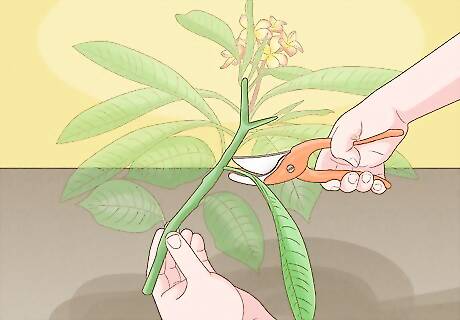
Cut the flowers and leaves off the branch using pruning shears. Existing flowers and leaves will compete with new root growth and inhibit the growth of your cutting. To prevent this, use your sterilized pruning shears to cut off any leaves or flowers from your cutting at a 45-degree, downward angle. Check the cut you made at the end of the branch. If it’s jagged, clean it up by re-clipping the end at a downward, 45-degree angle using pruning shears. Be sure to wear gardening gloves, as the plumeria has a sticky sap that can get on your hands and clothing.
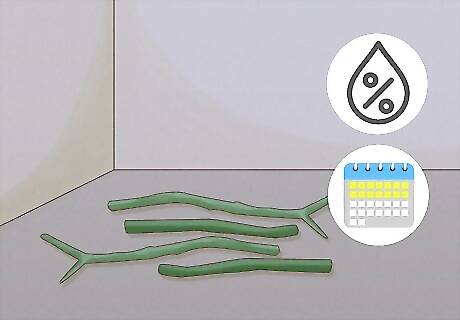
Dry out the cuttings in a shady, humid area for 1-2 weeks. It’s necessary to dry out your cuttings before you plant the plumeria. Let your cuttings sit for 1-2 weeks in a shady, humid area to allow the freshly cut end to callous over and dry out. If your plumeria cutting doesn't callous over, it won't root, making the drying-out period an essential step.
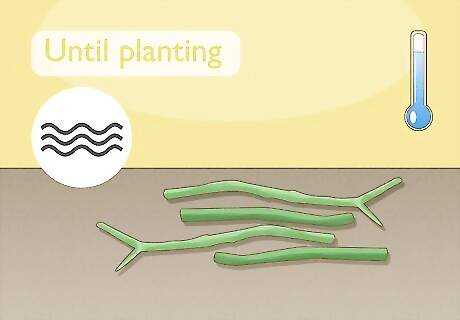
Store the cuttings in a cool, dry area until you’re ready to plant them. Once the plumeria has calloused and dried, the cuttings are ready for planting—hurray! If you plan to store the cuttings before planting them, wrap and secure the cut end of the cutting with plastic wrap and a rubber band. Store dried cuttings for up to 2-3 months, if necessary. Discard any cuttings that show signs of disease or mold (spotting, a fuzzy texture, yellowed leaves.)
Planting the Plumeria Cutting
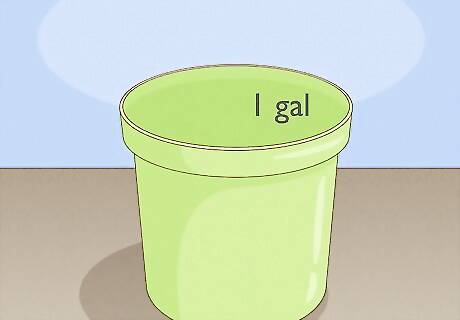
Select a 1 gallon (3.8 l) or larger pot for each cutting. Your pot size will determine how large your plumeria can grow, so opt for a bigger pot if you’re aiming for bountiful blooms! Ensure your pot of choice has drainage holes on the bottom so water doesn’t pool and rot your precious cutting. Each plumeria cutting will need a separate pot.
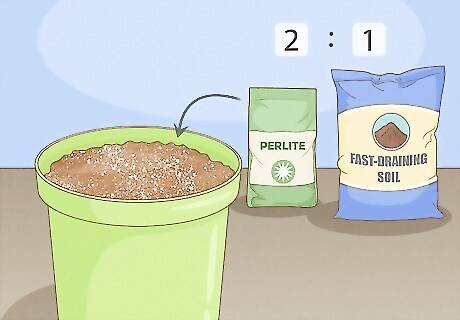
Fill a pot with 2 parts perlite and 1 part fast-draining potting soil. Thoroughly mix the perlite and potting soil so they're well incorporated. Fill the pot 1 inch (2.5 cm) to the brim to give the cutting enough medium to grow in and to prevent overflow when you water. Fast-draining potting mix will prevent mold and fungus from forming on your cutting—yes, please!
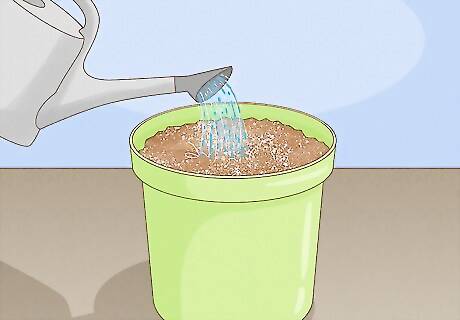
Pour water into the soil to dampen it. To ensure that your clipping doesn’t develop root rot later down the line, pour a bit of water into the pot to check that it drains properly. The water you poured into the pot should drain from its drainage holes on the bottom. Add 1 part vermiculite to the potting mixture if your soil isn’t draining properly.
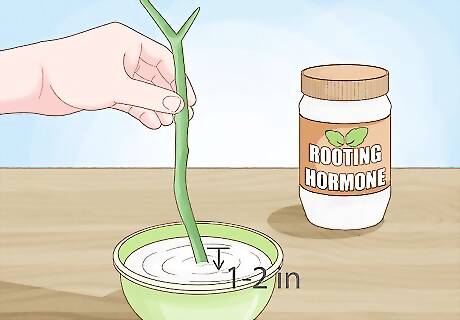
Dip the cutting tip into root growth hormone, if desired. While this isn’t necessary, root growth hormone will help initial roots to grow from your cutting. Dip the cut end of the cutting into a cup of water first, then dip 1–2 inches (2.5–5.1 cm) of the cutting into the root growth hormone powder. Dipping the cutting in water first will help the growth powder stick to your cutting. Make your own rooting powder using honey, or aloe!
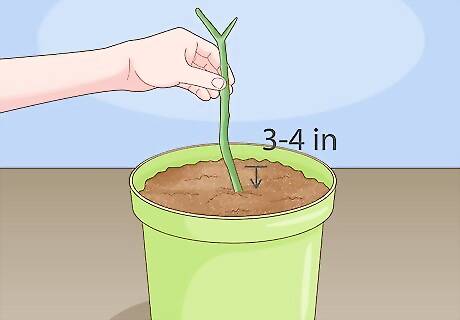
Push the cutting 3–4 inches (7.6–10.2 cm) into the soil in the pot. Push the cut end of the cutting into the soil in the center of the pot. Add more potting mix to the top of the soil to help hold the cutting in place, then pack the soil around the cutting to ensure it doesn't move or shift as the roots grow.
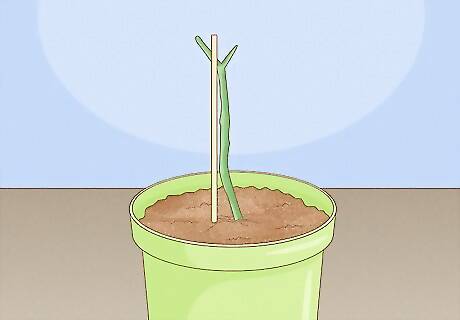
Add stakes to support large cuttings if necessary. If your cutting is too large or is falling over, use a stake to keep it straight in the pot. To do this, plant a stake deep into the soil in the pot, then attach the stake to the cutting with wire or string. This will help hold the cutting in place as the roots form.

Put the plumeria in a warm place and wait 4-8 weeks for it to take root. You’ll know it’s growing when you start to see new buds forming on the top of the cutting. During this stage, plumerias require very little water and should only be watered about once every 10 days. Plumeria should be kept in temperatures above 60 °F (16 °C). Place the pot on a seedling mat to increase soil temperature and encourage the roots to grow.
Caring for Plumeria
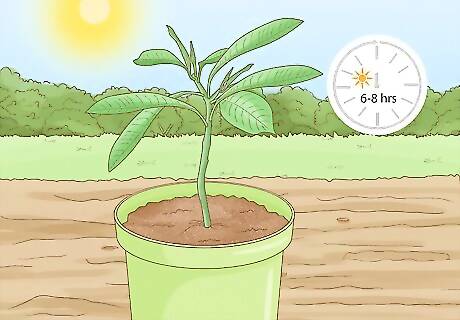
Place the cutting in a spot that gets 6-8 hours of sunlight daily. If your plumeria doesn’t get enough sunlight, flower buds will not form. A happy plumeria is a well-sunned plumeria! Place the pot in direct sunlight if you plan on growing the plant outside.
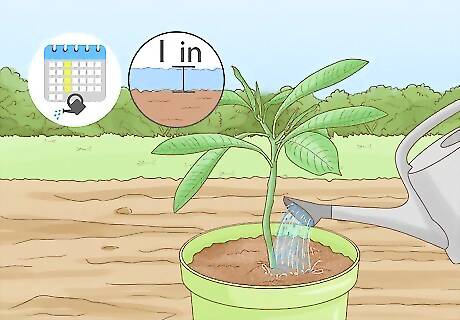
Water your plumeria with at least 1 inch (2.5 cm) of water per week. If it rains regularly where you live and you’re keeping the plumeria outside, you won’t need to water it. However, if your area is suffering from a drought or the plumeria is indoors, thoroughly soak the top of the soil and let the water drain out of the bottom of the pot once a week. Don’t overwater your plumeria, as this will kill it. If the soil 1 inch (2.5 cm) deep feels moist, it doesn’t need water.
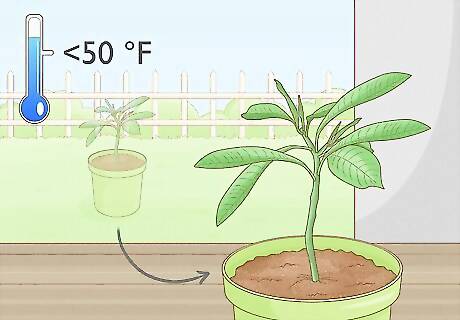
Bring your plumeria inside if it drops below 50 °F (10 °C). Plumeria doesn’t fare well in the cold. While plumerias have no problem growing in room temperature conditions, frost and cold can kill the plant or cause it to go dormant. To prevent this, bring your plant inside when it becomes too cold. If you transplanted your plumeria cutting into the ground, it will go through a normal 3-month dormancy phase when the temperature gets cold.

Spray fertilizer on the plant every 1-3 weeks during the growing season. Thoroughly spray down the leaves and stem of your plumeria with a liquid fertilizer spray throughout the spring and summer months to boost blooms. With all your hard work and TLC, your plumeria could grow up to 10-12 feet (3-3.6 meters)! Mix or dilute the fertilizer according to the instructions on the label, if necessary.

Prune your plumeria to shape it or to remove dead branches. Start by sterilizing your pruning shears with alcohol. Then, cut the unruly or diseased branch off 1 inch (2.5 cm) from the plant's main stem at a 45-degree angle. Pruning your plumeria helps prevent disease and stops branches from growing in an undesired direction. The best time to prune plumeria is in early spring.
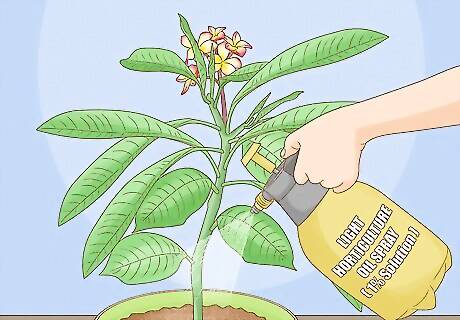
Spray an infested plant with light horticultural oil. If your plumeria is suffering from mites or flies, a light horticultural oil spray (1% solution) can keep them at bay. Simply spray the leaves and main stem with the horticultural oil, and you’re good to go!



















Comments
0 comment